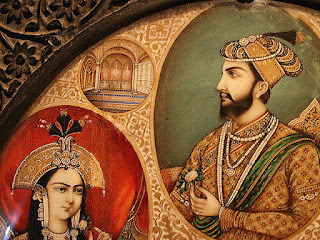Chief components of Mughal paintings were Indian, Persian and Chinese. The imported style introduced by the Mughals mingled with the contemporary Indian schools of painting flourishing in different parts of the country. Gujarat, Rajputana and Kashmir were important centres of Indian painting in the early Mughal period. Court life and natural life inspire most of the subjects of Mughal paintings. Portraits of the Mughal emperors are also one of the themes of the Mughal paintings.
Persian painter Abdus Samad was appointed tutor to the Prince Akbar by Humayun. Abdus Samad and Mir Sayyid Ali were invited to the Mughal court to prepare a lavishly illustrated manuscript of the Persian translation of the Hamzanama, the celebrated Arab epic about a legend Hamza. Hamzanama had 1004 illustrated pages in its twelve volumes.
Development of fresco painting (Frescoes on the walls of Fatehpur Sikri) was an important contribution to the field painting during Akbar’s period which also witnessed the introduction of European painting at the Mughal court.
Daswanth, Farrukh Beg and Basawan were the famous painters in Akbar’s court. Impressed by his talent, Akbar sent Daswanth to Abdus Samad. Daswanth’s illustration of the Persian translation of the Mahabharata is now in Jaipur. Baswan was another talented painter. Abul Fazal, the court historian, refers by name to thirteen Hindu and five Muslim painters in the court of Akbar.
Portrait painting made special progress during the reign of Jahangir who himself was an excellent connoisseur of painting. Ustad Mansur at his court was famous for his paintings of animal and human portraits.
Aga Reza and his son Abul Hasan from Herat in Afghanistan were employed by Jahangir. Abdul Hasan was bestowed the title of Nadir-uz-Saman ("Wonder of the Age") by Jahangir who took pride in his ability to recognise the artist by their paintings.
Shah Jahan was the last great royal patron of Mughal school of painting.
Key Points
- Abdus Samad was given the title of Shirin Qalam.
- Abul Hasan was given the title of Nadir-uz-Zaman ("Wonder of the Age") by Jahangir.
- Ustad Mansur was given the title of Nadir-ul-Asr ("Unequalled of the age").

Comments
Post a Comment